机器学习 —— 概率图模型(Homework: Representation)
前两周的作业主要是关于Factor以及有向图的构造,但是概率图模型中还有一种更强大的武器——双向图(无向图、Markov Network)。与有向图不同,双向图可以描述两个var之间相互作用以及联系。描述的方式依旧是factor.本周的作业非常有实际意义——基于马尔科夫模型的图像文字识别系统(OCR)
图像文字识别系统(OCR)在人工智能中有着非常重要的应用。但是受到图像噪声,手写体变形,连笔等影响基于图像的文字识别系统比较复杂。PGM的重要作用就是解决那些测量过程复杂,测量结果不一定对,连续测量的情况(单次测量,前后比对,反复斟酌,寻找最优)。而英文文字往往由字母组成单词,所以适合利用概率图模型来进行建模。
概率图模型 OCR SLAM
单次测量——对单个字母的图像识别不准确;单次配准,转移矩阵求取不准确;
前后比对——结合单词字母组合规律 ;结合上一帧或前几帧的观测;
反复斟酌—— 图模型中更复杂的联系
寻找最优—— MAP估计

在文字识别系统中,文字的图像(var:I)总是被观测到,而所需要求得的字母(var(C))总是无法被观测到。所以我们建模的是P(C|I),此时的马尔科夫模型更为特殊,被称为条件随机场。
1、单次测量
在构建复杂的概率图模型之前,应该先从简单的入手。尽管单次不准,也应该先对单次观测进行推测。所以,对于给定图像,获取其与字母之间关系的factor是必要的。此时的图模型如图所示。

此时,每个字母都是单独的一个图,我们也只需要指定每个字母与图像之间的factor——phi(I,C).由于图像总是被观测到了,所以这个factor里的变量只有C。但是,对于每个不同的小图而言,factor的val是不一样的,因为val代表了var取card中每个值的概率。factor的var应为字母的序号。card=26代表var的取值范围。val则由computeImageFactor给出。
由于图片不同会导致var的取值分布不同,所以这不能像之前那样构造好一个factor然后批量复制,而需要单独计算。在factor.val的计算中,使用了以下函数
function P = ComputeImageFactor (img, imgModel)
% This function computes the singleton OCR factor values for a single
% image.
%
% Input:
% img: The 16x8 matrix of the image
% imgModel: The provided, trained image model
%
% Output:
% P: A K-by-1 array of the factor values for each of the K possible
% character assignments to the given image
%
% Copyright (C) Daphne Koller, Stanford University, 2012 X = img(:);
N = length(X);
K = imgModel.K; theta = reshape(imgModel.params(1:N*(K-1)), K-1, N);
bias = reshape(imgModel.params((1+N*(K-1)):end), K-1, 1); W = [ bsxfun(@plus, theta * X, bias) ; 0 ];
W = bsxfun(@minus, W, max(W));
W = exp(W); P=bsxfun(@rdivide, W, sum(W)); end
函数中最重要的信息被藏在了imageModel.params里,点开params发现是一个3225×1的向量,而结合reshape指令来看,这个向量是图像像素点的值与字母一一对应的权重。最后利用sigmoid函数将此权重转换成了factor.val。故此factor的代码如下所示:
function factors = ComputeSingletonFactors (images, imageModel)
% This function computes the single OCR factors for all of the images in a
% word.
%
% Input:
% images: An array of structs containing the 'img' value for each
% character in the word. You could, for example, pass in allWords{1} to
% use the first word of the provided dataset.
% imageModel: The provided OCR image model.
%
% Output:
% factors: An array of the OCR factors, one for every character in the
% image.
%
% Hint: You will want to use ComputeImageFactor.m when computing the 'val'
% entry for each factor.
%
% Copyright (C) Daphne Koller, Stanford University, 2012 % The number of characters in the word
n = length(images); % Preallocate the array of factors
factors = repmat(struct('var', [], 'card', [], 'val', []), n, 1); % Your code here:
for i = 1:n
factors(i).var = i;
factors(i).card = imageModel.K;
factors(i).val = ComputeImageFactor(images(i).img,imageModel);
end
end
显然对于一个9字母的单词而言,运行此代码可构建PGM,所谓的PGM实际上是一系列factor.
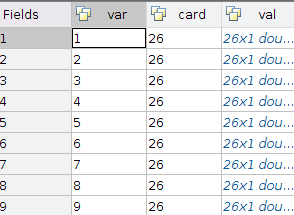
如此简单的模型同样可以进行有效的推断。推断通过调用预编译好的c代码实现,此时的识别结果为:字母识别率77%,单词识别率22%.显然此时的识别成功率基本完全由训练好的params决定。仅仅是图片与字母的一一对应。
2、前后比对
2.1 相邻字母
显然对于英文单次而言,相邻字母的组合也是有一定先验信息的。比如q后面接h的概率要小于q后面接u的概率。这种关系对推测是有益的。此时的图模型如下所示:

显然与之前相比,此时的图模型需要考虑相邻字母之间的关系(factor),此时factor的var应该有两个,且应该是相邻的,如:1 2;2 3;3 4...而每个var的card依旧是[26 26],一幅图中var一旦确定了,有了唯一的编号,那么card是不可以改变的。两个相邻字母的factor.val规模非常庞大了,应该为26*26 = 676. 但是此时的factor.val与图像观测值并没有关系,它只是var之间的一种联系。也就是说,此时的factor是可以复制的。只需要改变var,其他的值都应该是一样的。factor的计算如下:
function factors = ComputePairwiseFactors (images, pairwiseModel, K)
% This function computes the pairwise factors for one word and uses the
% given pairwise model to set the factor values.
%
% Input:
% images: An array of structs containing the 'img' value for each
% character in the word.
% pairwiseModel: The provided pairwise model. It is a K-by-K matrix. For
% character i followed by character j, the factor value should be
% pairwiseModel(i, j).
% K: The alphabet size (accessible in imageModel.K for the provided
% imageModel).
%
% Output:
% factors: The pairwise factors for this word.
%
% Copyright (C) Daphne Koller, Stanford University, 2012 n = length(images); % If there are fewer than 2 characters, return an empty factor list.
if (n < 2)
factors = [];
return;
end val_ = reshape(pairwiseModel,K*K,1); factors = repmat(struct('var', [], 'card', [K K], 'val', val_), n - 1, 1); % Your code here:
for i = 1 : n-1
factors(i).var =[i,i+1];
end
end
显然,这里的关键val,又是由神秘参数pairwiseModel决定的。pairwiseModel实际上是一个26×26的矩阵,它指定了两个字母相邻的可能性。点开发现里面有很多0,即代表两个字母几乎不可能相邻。此模型可由字典统计获得。实际上,这里置0是一件挺危险的事情,这里可以这么做是因为足够自信。
如果使用相邻字母构建PGM,则又可以得到一些factor.如下所示:

此时的识别结果为:字母识别率79.16%,单词识别率26%,显然,单词识别率获得了较大的提升。
2.2 三字母组合
考虑到双字母组合可以对识别率提升较大,那么3字母组合也应该可以提升识别率。考虑一个单词的i,i+1,i+2个字母之间的关系,则图模型如下所示:
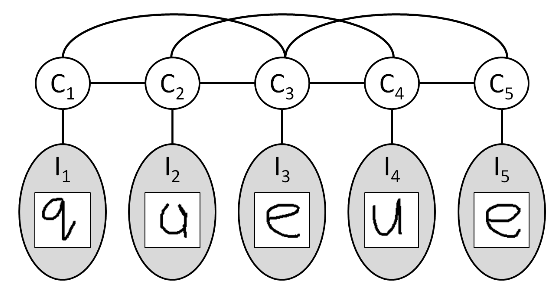
显然,我们需要做的工作是继续增加factor —— phi(i,i+1,i+2),此factor的var为i,i+1,i+2,card为26 26 26. 剩下最重要的val依旧由神秘的数字决定。然后,val一共需要26*26*26=17576个值来决定。显然我们针对每个组合均设计一个val,哪怕是穷尽字典也需要大量的运算。所以,我们只针对2000个常用的组合(ing,ght.....)给予较高的权重(大于1),而其他组合则赋予1(不管之)。此时特征的稀疏性表现的更加明显了。factor的计算代码如下:
function factors = ComputeTripletFactors (images, tripletList, K)
% images = allWords{1};
% K = 26;
% This function computes the triplet factor values for one word.
%
% Input:
% images: An array of structs containing the 'img' value for each
% character in the word.
% tripletList: An array of the character triplets we will consider (other
% factor values should be 1). tripletList(i).chars gives character
% assignment, and triplistList(i).factorVal gives the value for that
% entry in the factor table.
% K: The alphabet size (accessible in imageModel.K for the provided
% imageModel).
%
% Hint: Every character triple in the word will use the same 'val' table.
% Consider computing that array once and then resusing for each factor.
%
% Copyright (C) Daphne Koller, Stanford University, 2012
n = length(images);
% If the word has fewer than three characters, then return an empty list.
if (n < 3)
factors = [];
return
end
val_init = ones(K*K*K,1);
num_zhiding = length(tripletList);
for i = 1:num_zhiding
triplet_i = tripletList(i);
assign_ = triplet_i.chars;
index_ = AssignmentToIndex(assign_,[K K K]);
val_init(index_) = triplet_i.factorVal;
end
factors = repmat(struct('var', [], 'card', [K K K], 'val', [val_init]), n - 2, 1);
% Your code here:
for i = 1: n-2
factors(i).var = [i i+1 i+2];
end
end
此时又可以得到一些factor,如下:
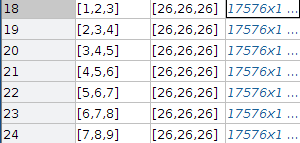
增加了这些factor之后,字母的识别率上升为80.3%,单词识别率上升为24%.显然,上升的速度放缓了,由于三字母的组合在很多单词中并不容易碰见,故对于识别率的提升效果有限。
3、反复斟酌
显然相邻信息已经无法满足效果提升的要求了,所以我们需要寻找更多有用的信息并将其带入PGM中。对于常见的手写体来说,人们对于同一个字母的书写总是相似的。也就是说,同一个单词中,字母之间应该两两存在联系,如果其观测值(图片)相似,则这两个字母有很大的可能性是相同的。此时的概率图如图所示:
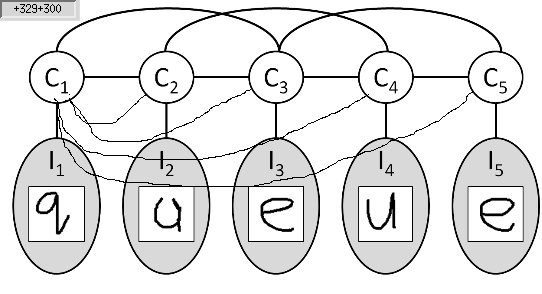
节点与节点之间是两两相连的(图中为了查看方便,只连了第一个节点与其他节点)。显然,1 2;1 3;本就相连,此线条不是重复了么?实际上不是的,之前相连的factor所表示的是相邻信息,而此时相连的factor需要表示两幅图的相似程度。此factor的本质应该是phi(C1,C2,I1,I2),但是由于I1,I2被观测到了,所以var仅为C1,C2,card 依旧为[26 26]——card表示随机变量的取值范围,而不是随机变量序号的取值范围,且要与之前对应。val则应该由两幅图的相似程度决定。所以这又是一个不能直接复制的factor,因为其与观测值有关。
此factor由以下程序给出:
function factor = ComputeSimilarityFactor (images, K, i, j)
% This function computes the similarity factor between two character images
% in one word --- which characters is given by indices i and j (a
% description of how the factor should be computed is given below).
%
% Input:
% images: A struct array of character images from one word.
% K: The alphabet size.
% i,j: The scope of that factor. That is, you should construct a factor
% between characters i and j in the images array.
%
% Output:
% factor: The similarity factor between these two characters. For any
% assignment C_i != C_j, the factor value should be one. For any
% assignment C_i == C_j, the factor value should be
% ImageSimilarity(I_i, I_j) --- ie, the computed value given by
% ImageSimilarity.m on the two images.
%
% Copyright (C) Daphne Koller, Stanford University, 2012 factor = struct('var', [i j], 'card', [K K], 'val',ones(K*K,1));
for i_ = 1:K
for j_ = 1:K
indx_ = AssignmentToIndex([i_ j_],[K K]);
if(i_ == j_)
factor.val(indx_) = ImageSimilarity(images(i).img,images(j).img);
end
end
end % Your code here: end
其中,ImageSimilarity 计算的是两幅图的相似程度,利用两幅图向量化后夹角的余弦进行量化。
显然,在此factor不可直接复制的情况下,我们还需要生成整幅图所有的factors.由以下程序给出:
function factors = ComputeAllSimilarityFactors (images, K)
% This function computes all of the similarity factors for the images in
% one word.
%
% Input:
% images: An array of structs containing the 'img' value for each
% character in the word.
% K: The alphabet size (accessible in imageModel.K for the provided
% imageModel).
%
% Output:
% factors: Every similarity factor in the word. You should use
% ComputeSimilarityFactor to compute these.
%
% Copyright (C) Daphne Koller, Stanford University, 2012 n = length(images);
nFactors = nchoosek (n, 2); factors = repmat(struct('var', [], 'card', [K K], 'val', []), nFactors, 1); % Your code here:
num_factor_ =1;
for i = 1:n
for j = i+1:n
factors(num_factor_) = ComputeSimilarityFactor(images,K,i,j);
num_factor_ = num_factor_+1;
end
end
end
但是值得注意的是,增加此factors后,其图模型增加了如下变量:
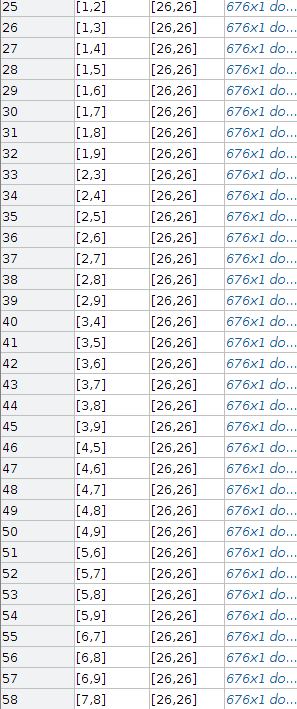
注意此图并未截全。如果单词较长(9字母)的情况下,factors会剧烈增长,这会给图模型的推断带来极大的计算困难。然后很多情况下,单词中重复的字母是少数的,考虑2组重复字母足以应对大部分单词。所以为了降低计算难度,我们将图像相似的factors减小,仅保留最相似(factor.val最大)的两组。所使用的代码如下:
function factors = ChooseTopSimilarityFactors (allFactors, F)
% This function chooses the similarity factors with the highest similarity
% out of all the possibilities.
%
% Input:
% allFactors: An array of all the similarity factors.
% F: The number of factors to select.
%
% Output:
% factors: The F factors out of allFactors for which the similarity score
% is highest.
%
% Hint: Recall that the similarity score for two images will be in every
% factor table entry (for those two images' factor) where they are
% assigned the same character value.
%
% Copyright (C) Daphne Koller, Stanford University, 2012 % If there are fewer than F factors total, just return all of them.
if (length(allFactors) <= F)
factors = allFactors;
return;
end % Your code here:
n_factors = length(allFactors);
n_img = max(allFactors(n_factors).var); start_ = n_factors-nchoosek(n_img,2)+1;
Similarity =[];
for i = start_ : n_factors
Similarity =[Similarity;i max(allFactors(i).val)];
end Similarity_paixu = sortrows(Similarity,-2);
factors_to_keep = Similarity_paixu(1:F,1);
factors_to_remove = setdiff(start_:n_factors,factors_to_keep);
allFactors(factors_to_remove,:)=[];
factors = allFactors; %%% REMOVE THIS LINE end
最终,PGM的factors如下所示:

利用推断算法对此模型计算,可以求得:文字识别率81.6%,单词识别率37%.相比于单纯的图片-文字识别,识别率提高了近一倍!!!概率图模型的效果是显著的。
4、总结
最后,大家肯定好奇文字图片到底是啥,如下:

识别结果如下:

所有代码请点这里
机器学习 —— 概率图模型(Homework: Representation)的更多相关文章
- 机器学习 —— 概率图模型(Homework: CRF Learning)
概率图模型的作业越往后变得越来越有趣了.当然,难度也是指数级别的上涨啊,以至于我用了两个周末才完成秋名山神秘车牌的寻找,啊不,CRF模型的训练. 条件随机场是一种强大的PGM,其可以对各种特征进行建模 ...
- 机器学习 —— 概率图模型(Homework: MCMC)
除了精确推理之外,我们还有非精确推理的手段来对概率图单个变量的分布进行求解.在很多情况下,概率图无法简化成团树,或者简化成团树后单个团中随机变量数目较多,会导致团树标定的效率低下.以图像分割为例,如果 ...
- 机器学习 —— 概率图模型(Homework: Exact Inference)
在前三周的作业中,我构造了概率图模型并调用第三方的求解器对器进行了求解,最终获得了每个随机变量的分布(有向图),最大后验分布(双向图).本周作业的主要内容就是自行编写概率图模型的求解器.实际上,从根本 ...
- 机器学习 —— 概率图模型(Homework: StructuredCPD)
Week2的作业主要是关于概率图模型的构造,主要任务可以分为两个部分:1.构造CPD;2.构造Graph.对于有向图而言,在获得单个节点的CPD之后就可依据图对Combine CPD进行构造.在获得C ...
- 机器学习 —— 概率图模型(Homework: Factors)
Talk is cheap, I show you the code 第一章的作业主要是关于PGM的因子操作.实际上,因子是整个概率图的核心.对于有向图而言,因子对应的是CPD(条件分布):对无向图而 ...
- 机器学习 —— 概率图模型(学习:CRF与MRF)
在概率图模型中,有一类很重要的模型称为条件随机场.这种模型广泛的应用于标签—样本(特征)对应问题.与MRF不同,CRF计算的是“条件概率”.故其表达式与MRF在分母上是不一样的. 如图所示,CRF只对 ...
- 机器学习 —— 概率图模型(Homework: Structure Learning)
概率图的学习真的要接近尾声了啊,了解的越多越发感受到它的强大.这周的作业本质上是data mining.从数据中学习PGM的结构和参数,完全使用数据驱动 —— No structure, No par ...
- 机器学习 —— 概率图模型(CPD)
CPD是conditional probability distribution的缩写,翻译成中文叫做 条件概率分布.在概率图中,条件概率分布是一个非常重要的概念.因为概率图研究的是随机变量之间的练习 ...
- 机器学习 —— 概率图模型(推理:MAP)
MAP 是最大后验概率的缩写.后验概率指的是当有一定观测结果的情况下,对其他随机变量进行推理.假设随机变量的集合为X ,观察到的变量为 e, W = X-e , AP = P(W|e). 后验概率和联 ...
随机推荐
- vs2008中使用Newtonsoft.Json
异常:找不到方法:“Boolean System.Runtime.Serialization.DataContractAttribute.get_IsReference()” 在使用Newtonsof ...
- Django Form的学习
django.forms 是Django处理form的库 本质上可以直接通过对HttpRequest达到同样的效果,但是django.from带来更便捷的处理方式.功能有几点 通过form类 ...
- eclipse增加浏览器chrome
1.安装完了google chrome游览器后,如何让eclipse直接用chrome打开jsp 2.添加到eclipse环境中即可, Window(菜单) -- preferences 增加成功后, ...
- (转)《深入理解java虚拟机》学习笔记10——并发编程(二)
Java的并发编程是依赖虚拟机内存模型的三个特性实现的: (1).原子性(Atomicity): 原子性是指不可再分的最小操作指令,即单条机器指令,原子性操作任意时刻只能有一个线程,因此是线程安全的. ...
- 在Debian中安装VMware Workstatption 12
在Debian中安装VMware Workstatption 12-----------------------------------------------> 下载文件: *vmwar ...
- andriod ADB命令的使用
android ADB命令的使用 ADB是一个 客户端-服务器端 程序, 其中客户端是你用来操作的电脑, 服务器端是android设备. 先说安装方法, 电脑上需要安装客户端. 客户端包含在sdk里. ...
- How to install DIG dns tool on windows 7
This guide explain how to install dig dns tool on windows 7 in few steps: 1. First go to http://www. ...
- C++(MFC)
C++(MFC) 1.关联变量(与控件关联): (1)一组单选按钮:需要将第一个单选按钮的Group选项设为true,则单选按钮就为一组(组框为标示作用).选中第一个则为0,第二个为1,依次类推(P2 ...
- HttpWebRequest,HttpWebResponse的用法和用途
1.用途:HettpWebRequest,HettpWebResponse用途和webServers的作用差不多,都是得到一个页面传过来的值.HttpWebRequest 2.用法:--------- ...
- android 中使用回调方法(适用于自定义view传值到activity、adapter传值到activity)
如图所示: 每当listview中有选中的操作时都需要发消息给activity,用来实时改变真实需要支付的剩余金额. 代码暂不公开啦!公司项目!
